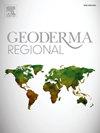Application of mid-infrared spectroscopy for soil analysis in calcareous Argania spinosa forests in Morocco
IF 3.3
2区 农林科学
Q2 SOIL SCIENCE
引用次数: 0
Abstract
Mid-infrared (MIR) spectroscopy is a promising tool to meet the growing global demand for soil data, as it allows a rapid and inexpensive collection of infrared spectra. Despite an increasing number of soil property predictions based on such datasets, the data availability in arid regions is still sparse. This is particularly problematic as the presence of inorganic carbonates poses additional challenges to model development in arid regions while limiting the applicability of models developed in more humid climates. In this study, the potential application of Fourier transform infrared (FTIR) spectroscopy for soil analysis in degraded Argania spinosa populations is assessed. The underlying objective was twofold. First of all, the models generated may help to monitor soil conditions in an endangered UNESCO biosphere reserve. Secondly, knowledge gaps in arid, calcareous regions of Northern Africa are addressed by creating a sample collection of considerable size. Spectra of 397 soil samples were recorded in addition to conventional laboratory measurements of pH, percolation stability (PS), nitrogen (N), total organic carbon (TOC), and inorganic carbon (iC). Partial least squares (PLS) regression was then used to predict these soil properties based on the MIR records. The models were calibrated, independently validated, and evaluated based on the coefficient of determination (R2), the root mean square error (RMSE), the ratio of performance to deviation (RPD), and the ratio of performance to interquantile range (RPIQ). Promising model validation results were obtained for N (R2: 0.86, RPD: 2.71, RPIQ: 2.45, RMSE: 0.03), TOC (R2: 0.89, RPD: 3.06, RPIQ: 1.72, RMSE: 0.44), and iC (R2: 0.96, RPD: 5.32, RPIQ: 2.01, RMSE: 0.15), but not for the pH (R2: 0.37, RPD: 1.27, RPIQ: 1.51, RMSE: 0.17) or PS (R2: 0.30, RPD: 1.20, RPIQ: 1.31, RMSE: 80.54). Especially the results of the N prediction show that reliable MIR models can be trained in arid environments despite noticeable effects of ubiquitous iC. In contrast, the pH and PS models highlight clear limitations of the technique for surrogate calibrations.
中红外光谱在摩洛哥钙质棘豆森林土壤分析中的应用
中红外(MIR)光谱是一种很有前途的工具,可以满足全球对土壤数据日益增长的需求,因为它可以快速而廉价地收集红外光谱。尽管基于这些数据集的土壤性质预测越来越多,但干旱地区的数据可用性仍然很少。这尤其成问题,因为无机碳酸盐的存在给干旱地区的模式开发带来了额外的挑战,同时限制了在更潮湿气候中开发的模式的适用性。本文探讨了傅里叶变换红外光谱技术在退化棘毛蚶种群土壤分析中的应用前景。潜在的目标是双重的。首先,生成的模型可能有助于监测联合国教科文组织濒危生物圈保护区的土壤状况。其次,通过建立相当规模的样本收集来解决北非干旱、钙质地区的知识差距。除了常规实验室测量pH、渗透稳定性(PS)、氮(N)、总有机碳(TOC)和无机碳(iC)外,还记录了397个土壤样品的光谱。然后使用偏最小二乘(PLS)回归来预测这些土壤性质基于MIR记录。对模型进行校准、独立验证,并根据决定系数(R2)、均方根误差(RMSE)、性能与偏差比(RPD)和性能与分位数间差比(RPIQ)进行评估。N (R2: 0.86, RPD: 2.71, RPIQ: 2.45, RMSE: 0.03)、TOC (R2: 0.89, RPD: 3.06, RPIQ: 1.72, RMSE: 0.44)和iC (R2: 0.96, RPD: 5.32, RPIQ: 2.01, RMSE: 0.15)的模型验证结果令人满意,但pH (R2: 0.37, RPD: 1.27, RPIQ: 1.51, RMSE: 0.17)或PS (R2: 0.30, RPD: 1.20, RPIQ: 1.31, RMSE: 80.54)的模型验证结果不理想。特别是氮的预测结果表明,尽管普遍存在iC的影响,但在干旱环境中仍可以训练可靠的MIR模型。相比之下,pH和PS模型突出了替代校准技术的明显局限性。
本文章由计算机程序翻译,如有差异,请以英文原文为准。
求助全文
约1分钟内获得全文
求助全文
来源期刊

Geoderma Regional
Agricultural and Biological Sciences-Soil Science
CiteScore
6.10
自引率
7.30%
发文量
122
审稿时长
76 days
期刊介绍:
Global issues require studies and solutions on national and regional levels. Geoderma Regional focuses on studies that increase understanding and advance our scientific knowledge of soils in all regions of the world. The journal embraces every aspect of soil science and welcomes reviews of regional progress.
 求助内容:
求助内容: 应助结果提醒方式:
应助结果提醒方式:


